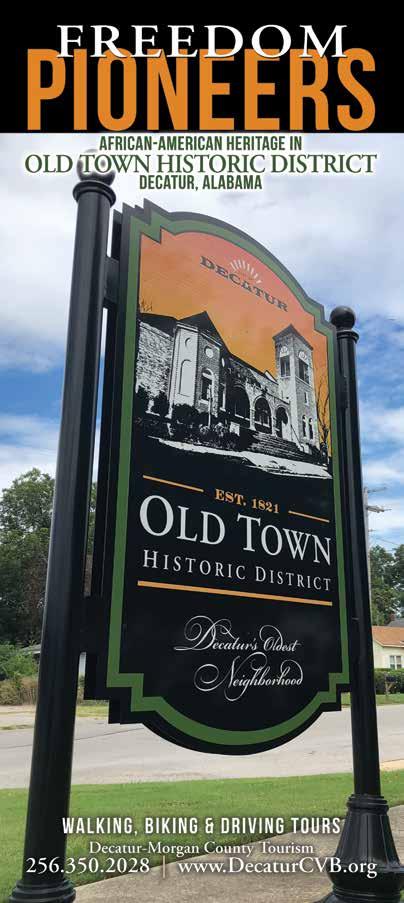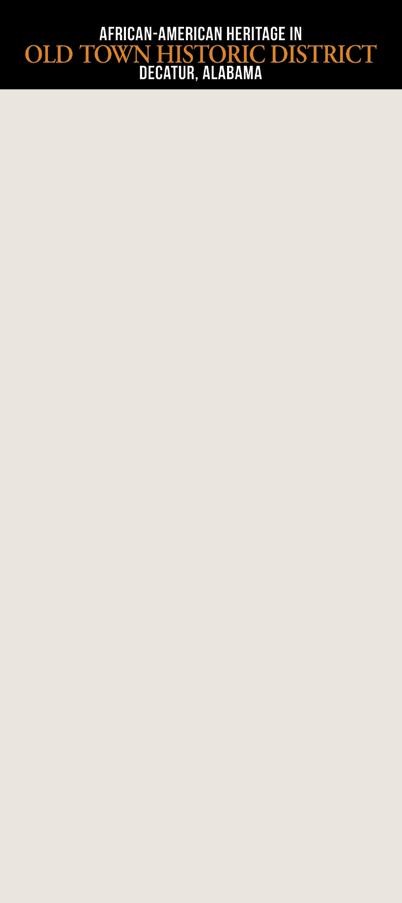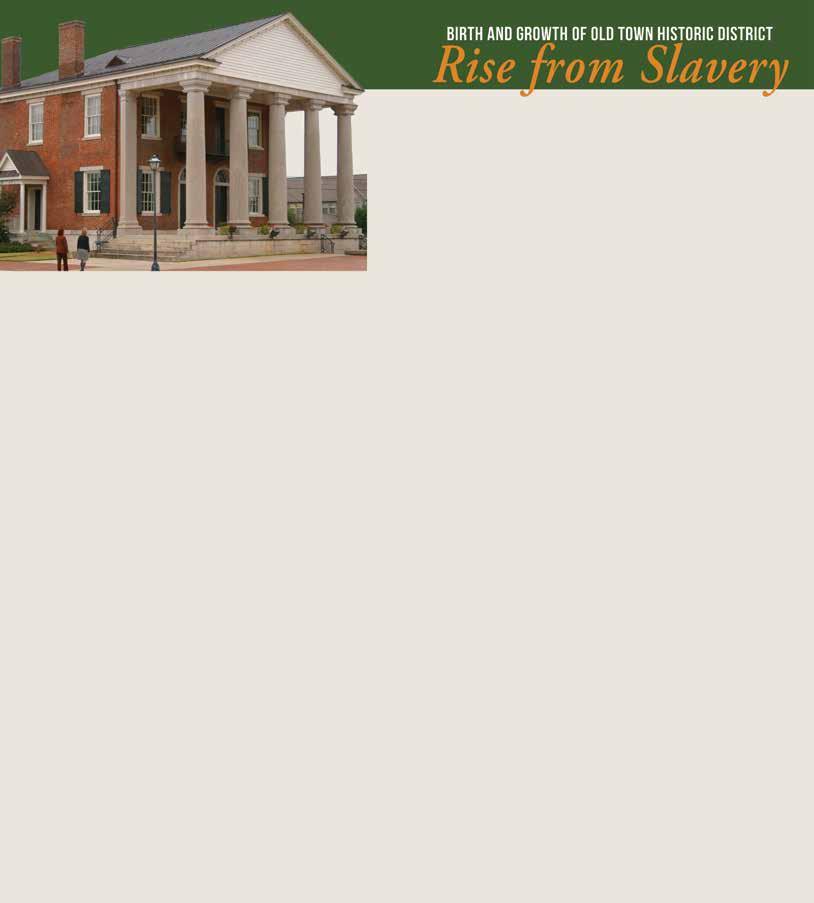
4 minute read
HISTORIC CHURCHES
King’s Memorial United Methodist Church
The oldest African American congregation in Decatur. The Reverend Richard “Dick”
Advertisement
Rather, Pastor. In 1850, bi-racial and black members, of Decatur First Methodist Episcopal Church, South began meeting for afternoon worship. In 1854, the people of color, with their own money, built their sanctuary on Lafayette Street between Bank Street and Railroad Street.
First Missionary Baptist Church
Founded in 1866, a year after emancipation.
The Reverend Alfred Peters, Pastor. The present church building was designed by prominent African American architect W.A. Rayfield in 1921 and constructed for $1,250.
The Rev. Elijah J. Lincoln organized church in 1878.
St. Stephen Primitive Baptist Church
Founded by Elder George Franklin, Pastor - 1875.
Wayman Chapel African Methodist Episcopal Church
The Reverend T.W. Coffee was assigned to Decatur Mission in 1877. The mission had six members.
Hidden in the pages of Decatur, Alabama’s history are the unmentioned and noteworthy African Americans, who made countless contributions to our city.
The River City was built on the backs of slaves and their descendants. The Old State Bank, which opened its doors July 29, 1833; is an example of their labor and craftsmanship. James Fennell, first Bank president, used slaves in the erection of the building. The slaves cut large stone pillars and hauled them from Trinity, Alabama to Decatur on ox drawn wagons. Many slaves worked on plantations, while others were hired out as blacksmiths, plasterers and laborers. The spirit and work of these pioneers continue to enrich and inspire past and future generations.
Civil War Soldiers
African Americans served both Union and Confederate Armies during the Civil War. The 106th United States Colored Infantry (USCI), organized in Decatur, is the first of only two black units raised in the State. Later the bravery of the 14th USCI was exhibited in Decatur, on October 28, 1864 when they saw combat with General John Bell Hood, resulting in a Union victory. The regiment first saw action on August 14-15, 1864, when it engaged in heavy skirmishing with raiding parties from General Joseph Wheeler’s cavalry at Dalton, Georgia. On August, 2009, a military grave marker was dedicated for 1st Alabama Cavalry, Union Civil War Soldier, Amos McKinney, who is buried at Magnolia-Sykes Cemetery in Decatur. Members of the 13th US Colored Troop and the 1st Alabama Cavalry reenactors (pictured at grave) took part in the ceremony. McKinney, who died Aug. 24, 1910 in Moulton, had been in an unmarked grave since his death. James J. Sykes purchased land for the Magnolia-Sykes Cemetery in 1901.
Early Businesses Old Town
Reconstruction to Early 1900s
• Robert Bridgeforth, Restaurant, 219 Bank Street; Livery Stable, 120 Market Street
• Robert Chardovoyne, Boot and Shoemaker
• J. W. Coleman, Grocer, Madison Street
• S. D. Elliott, Cleaning, Dyeing, 124 Lafayette Street

• A. G. Garth, Grocer, 602 Vine Street
• Lafayette Garth, Coal, 303 Bank Street
• Charles Grizzard, Grocer, 401 Wells Street
• Matilda Hall, Druggist and Notary Public
• Burrell W. Lemmons, Boarding House, Blacksmith and Grocer, Vine

• Sol Martin, Grocer, 426 W. Lafayette Street
• D. L. Miller, Barber, 602 Bank Street
• H. L. Murphy, Grocer, 505 Madison
• Madam Winnie Parker, Boarding House, Church Street
• Charles Ross, Barber, 307 Bank Street
• Samuel Schaudies, Boot and Shoemaker
• Willis E. Sterrs, M.D., Cottage Home Infirmary, Vine Street; Magnolia Drug Store and the People’s Dry Goods Store, Bank Street
• Solomon S. Sykes, Furniture, 225 Bank Street
• James J. Sykes, Grocer, Coal, Saloon, Tailor, Bank Street Constable John Mills - 1877
Politics Old Town
Notary and Justice of the Peace Charles P. Sykes - 1892
Decatur City Council
• Burrell W. Lemons - elected 1880, former slave was sworn in as Decatur’s first black Alderman
• Matthew Hewlett Banks - elected 1884 Alderman and Mayor Pro Tem
• Charles P. Sykes - elected 1888
• Hershel V. Cashin - elected 1892
• James J. Sykes - elected 1894
• Russell Priest - July 1986, appointed to Decatur City Council
• Collis Stevenson - elected 1988
• William “Butch” Matthews - elected 1991
• William “Billy” Jackson – elected 1996 to present. Served as Decatur City Council President 2004-2008
Decatur City School Board
Collis Stevenson, Tommy Sykes, and Michelle Gray King
MEDICAL & DENTAL OLD TOWN
Early 1900s
Willis E. Sterrs, M.D., State Board 1888 – Decatur’s first African American Physician. Noted surgeon, founder of Cottage Home Infirmary and School of Nursing (Decatur’s first hospital)
J.W. Aldridge, M.D., State Board 1902
Newlyn E. Cashin, M.D., State Board 1908
Deo V. Darden, M.D., State Board 1914
L.P. Jacobs, D.D.S., 1905 City Directory
Willis J. Wood, D.D.S., 1920 Census
Winston H. Sherard, M.D.
Journalism Old Town
Mrs. Eva Adelaide Sterrs
Guardian Newspaper, Founder & Editor, 1910-1917
Eva Sterrs, Boys Club Benefactor
Attorneys Old Town
Freedmen’s School - Operated by the Methodist Freedmen’s Aid Society, from 1867 -1874. This information reveals that education for children of color began directly after the Civil War when the Northern Methodist officially returned to Alabama and Decatur.
First Private School - The first private school set up in the St. Stephen Primitive Baptist Church in 1875. After a fire, the school moved to St. Paul’s Methodist Episcopal Church {now known as King’s Memorial United Methodist Church}.
Decatur Negro High - June 2, 1935
The Scottsboro Boys trials of the 1930’s, most of which took place in Decatur, Alabama, rank among the most significant cases in American legal history. Two precedent-setting United States Supreme Court cases came out of the trials. Worldwide media coverage laid bare the racial inequities of the American judicial system, especially within the racially segregated South.
Photo taken at Decatur Negro High School.
Dr. George Washington Carver, renowned Tuskegee Institute scientist, Tuskegee, Alabama, delivered the Baccalaureate address to the graduating class at the Princess Theatre. An integrated audience of over 1,000 people attended. Clifford Joel Hurston (brother of writer Zora Neal Hurston) was principal at the High School. During Dr. Carver’s visit the East End School’s name changed to Carver Elementary, in his honor. The principal was William J. Wilson. Other African-American Schools were: Cherry Street School East End (later named Carver Westlawn Elementary School Elementary School) Lakeside High School

